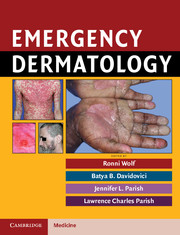Book contents
- Frontmatter
- Contents
- CONTRIBUTORS
- PREFACE
- Chap. 1 CELL INJURY AND CELL DEATH
- Chap. 2 CLEAN AND ASEPTIC TECHNIQUE AT THE BEDSIDE
- Chap. 3 NEW ANTIMICROBIALS
- Chap. 4 IMMUNOMODULATORS AND THE “BIOLOGICS” IN CUTANEOUS EMERGENCIES
- Chap. 5 CRITICAL CARE: STUFF YOU REALLY, REALLY NEED TO KNOW
- Chap. 6 ACUTE SKIN FAILURE: CONCEPT, CAUSES, CONSEQUENCES, AND CARE
- Chap. 7 CUTANEOUS SYMPTOMS AND NEONATAL EMERGENCIES
- Chap. 8 NECROTIZING SOFT-TISSUE INFECTIONS, INCLUDING NECROTIZING FASCIITIS
- Chap. 9 LIFE-THREATENING BACTERIAL SKIN INFECTIONS
- Chap. 10 BACTEREMIA, SEPSIS, SEPTIC SHOCK, AND TOXIC SHOCK SYNDROME
- Chap. 11 STAPHYLOCOCCAL SCALDED SKIN SYNDROME
- Chap. 12 LIFE-THREATENING CUTANEOUS VIRAL DISEASES
- Chap. 13 LIFE-THREATENING CUTANEOUS FUNGAL AND PARASITIC DISEASES
- Chap. 14 LIFE-THREATENING STINGS, BITES, AND MARINE ENVENOMATIONS
- Chap. 15 SEVERE, ACUTE ADVERSE CUTANEOUS DRUG REACTIONS I: STEVENS–JOHNSON SYNDROME AND TOXIC EPIDERMAL NECROLYSIS
- Chap. 16 SEVERE, ACUTE ADVERSE CUTANEOUS DRUG REACTIONS II: DRESS SYNDROME AND SERUM SICKNESS-LIKE REACTION
- Chap. 17 SEVERE, ACUTE COMPLICATIONS OF DERMATOLOGIC THERAPIES
- Chap. 18 SEVERE, ACUTE ALLERGIC AND IMMUNOLOGICAL REACTIONS I: URTICARIA, ANGIOEDEMA, MASTOCYTOSIS, AND ANAPHYLAXIS
- Chap. 19 SEVERE, ACUTE ALLERGIC AND IMMUNOLOGICAL REACTIONS II: OTHER HYPERSENSITIVITIES AND IMMUNE DEFECTS, INCLUDING HIV
- Chap. 20 GRAFT VERSUS HOST DISEASE
- Chap. 21 ERYTHRODERMA/EXFOLIATIVE DERMATITIS
- Chap. 22 ACUTE, SEVERE BULLOUS DERMATOSES
- Chap. 23 EMERGENCY MANAGEMENT OF PURPURA AND VASCULITIS, INCLUDING PURPURA FULMINANS
- Chap. 24 EMERGENCY MANAGEMENT OF CONNECTIVE TISSUE DISORDERS AND THEIR COMPLICATIONS
- Chap. 25 SKIN SIGNS OF SYSTEMIC INFECTIONS
- Chap. 26 SKIN SIGNS OF SYSTEMIC NEOPLASTIC DISEASES AND PARANEOPLASTIC CUTANEOUS SYNDROMES
- Chap. 27 BURN INJURY
- Chap. 28 EMERGENCY DERMATOSES OF THE ANORECTAL REGIONS
- Chap. 29 EMERGENCY MANAGEMENT OF SEXUALLY TRANSMITTED DISEASES AND OTHER GENITOURETHRAL DISORDERS
- Chap. 30 EMERGENCY MANAGEMENT OF ENVIRONMENTAL SKIN DISORDERS: HEAT, COLD, ULTRAVIOLET LIGHT INJURIES
- Chap. 31 ENDOCRINOLOGIC EMERGENCIES IN DERMATOLOGY
- Chap. 32 EMERGENCY MANAGEMENT OF SKIN TORTURE AND SELF-INFLICTED DERMATOSES
- Chap. 33 SKIN SIGNS OF POISONING
- Chap. 34 DISASTER PLANNING: MASS CASUALTY MANAGEMENT
- Chap. 35 CATASTROPHES IN COSMETIC PROCEDURES
- Chap. 36 LIFE-THREATENING DERMATOSES IN TRAVELERS
- Index
- References
Chap. 25 - SKIN SIGNS OF SYSTEMIC INFECTIONS
Published online by Cambridge University Press: 07 September 2011
- Frontmatter
- Contents
- CONTRIBUTORS
- PREFACE
- Chap. 1 CELL INJURY AND CELL DEATH
- Chap. 2 CLEAN AND ASEPTIC TECHNIQUE AT THE BEDSIDE
- Chap. 3 NEW ANTIMICROBIALS
- Chap. 4 IMMUNOMODULATORS AND THE “BIOLOGICS” IN CUTANEOUS EMERGENCIES
- Chap. 5 CRITICAL CARE: STUFF YOU REALLY, REALLY NEED TO KNOW
- Chap. 6 ACUTE SKIN FAILURE: CONCEPT, CAUSES, CONSEQUENCES, AND CARE
- Chap. 7 CUTANEOUS SYMPTOMS AND NEONATAL EMERGENCIES
- Chap. 8 NECROTIZING SOFT-TISSUE INFECTIONS, INCLUDING NECROTIZING FASCIITIS
- Chap. 9 LIFE-THREATENING BACTERIAL SKIN INFECTIONS
- Chap. 10 BACTEREMIA, SEPSIS, SEPTIC SHOCK, AND TOXIC SHOCK SYNDROME
- Chap. 11 STAPHYLOCOCCAL SCALDED SKIN SYNDROME
- Chap. 12 LIFE-THREATENING CUTANEOUS VIRAL DISEASES
- Chap. 13 LIFE-THREATENING CUTANEOUS FUNGAL AND PARASITIC DISEASES
- Chap. 14 LIFE-THREATENING STINGS, BITES, AND MARINE ENVENOMATIONS
- Chap. 15 SEVERE, ACUTE ADVERSE CUTANEOUS DRUG REACTIONS I: STEVENS–JOHNSON SYNDROME AND TOXIC EPIDERMAL NECROLYSIS
- Chap. 16 SEVERE, ACUTE ADVERSE CUTANEOUS DRUG REACTIONS II: DRESS SYNDROME AND SERUM SICKNESS-LIKE REACTION
- Chap. 17 SEVERE, ACUTE COMPLICATIONS OF DERMATOLOGIC THERAPIES
- Chap. 18 SEVERE, ACUTE ALLERGIC AND IMMUNOLOGICAL REACTIONS I: URTICARIA, ANGIOEDEMA, MASTOCYTOSIS, AND ANAPHYLAXIS
- Chap. 19 SEVERE, ACUTE ALLERGIC AND IMMUNOLOGICAL REACTIONS II: OTHER HYPERSENSITIVITIES AND IMMUNE DEFECTS, INCLUDING HIV
- Chap. 20 GRAFT VERSUS HOST DISEASE
- Chap. 21 ERYTHRODERMA/EXFOLIATIVE DERMATITIS
- Chap. 22 ACUTE, SEVERE BULLOUS DERMATOSES
- Chap. 23 EMERGENCY MANAGEMENT OF PURPURA AND VASCULITIS, INCLUDING PURPURA FULMINANS
- Chap. 24 EMERGENCY MANAGEMENT OF CONNECTIVE TISSUE DISORDERS AND THEIR COMPLICATIONS
- Chap. 25 SKIN SIGNS OF SYSTEMIC INFECTIONS
- Chap. 26 SKIN SIGNS OF SYSTEMIC NEOPLASTIC DISEASES AND PARANEOPLASTIC CUTANEOUS SYNDROMES
- Chap. 27 BURN INJURY
- Chap. 28 EMERGENCY DERMATOSES OF THE ANORECTAL REGIONS
- Chap. 29 EMERGENCY MANAGEMENT OF SEXUALLY TRANSMITTED DISEASES AND OTHER GENITOURETHRAL DISORDERS
- Chap. 30 EMERGENCY MANAGEMENT OF ENVIRONMENTAL SKIN DISORDERS: HEAT, COLD, ULTRAVIOLET LIGHT INJURIES
- Chap. 31 ENDOCRINOLOGIC EMERGENCIES IN DERMATOLOGY
- Chap. 32 EMERGENCY MANAGEMENT OF SKIN TORTURE AND SELF-INFLICTED DERMATOSES
- Chap. 33 SKIN SIGNS OF POISONING
- Chap. 34 DISASTER PLANNING: MASS CASUALTY MANAGEMENT
- Chap. 35 CATASTROPHES IN COSMETIC PROCEDURES
- Chap. 36 LIFE-THREATENING DERMATOSES IN TRAVELERS
- Index
- References
Summary
MANY SYSTEMIC infections have cutaneous presentations that sometimes are unspecific. These cutaneous signs and symptoms may be helpful in making the proper diagnosis, prescribing the appropriate therapy, and assisting in prevention. Some clinical manifestations of systemic infections highlight the possible infectious etiology for unusual cutaneous lesions.
Bacterial systemic infections may be more common in remote areas of the world; these same bacterial diseases also may be seen, however, in travelers or immigrants from these areas. Some of these infections, such as plague and melioidosis, are potential biological weapons used for bioterrorism.
MELIOIDOSIS
Melioidosis is a highly invasive and resistant infection caused by the gram-negative bacterium Burkholderia pseudomallei, which is synonymous with the old nomenclature Pseudomonas pseudomallei.
The first reported cases of P. pseudomallei were initially known as Whitmore disease. In 1911, a British pathologist, Captain Alfred Whitmore, described a case of pneumonia in a young boy in Burma, where P. pseudomallei was isolated as the causative agent. The term “melioidosis” was subsequently used in 1921. It is derived from the Greek word “melis” meaning “a distemper of donkeys,” because it resembles glanders, which causes mainly pulmonary disease in asses. This infection is endemic in Southeast Asia and North and Central Australia, and peaks during the monsoon seasons. The disease in those regions often causes septicemia and death. Melioidosis also occurs sporadically in temperate countries and is mostly imported by travelers.
- Type
- Chapter
- Information
- Emergency Dermatology , pp. 256 - 264Publisher: Cambridge University PressPrint publication year: 2011

